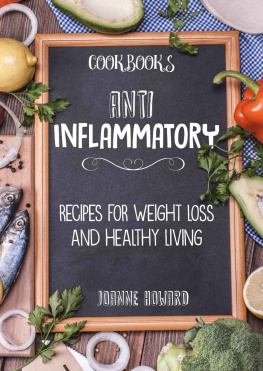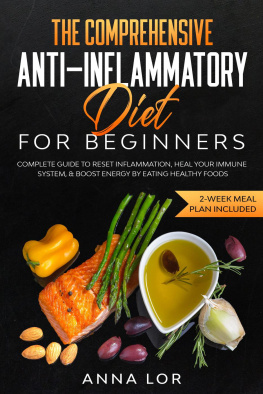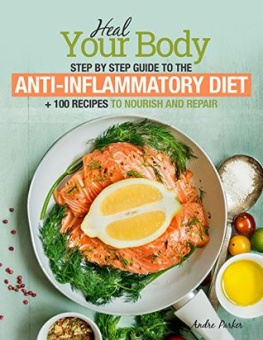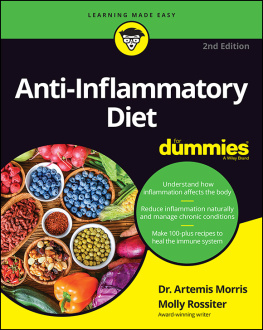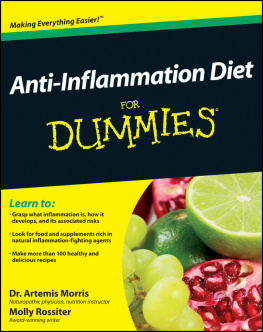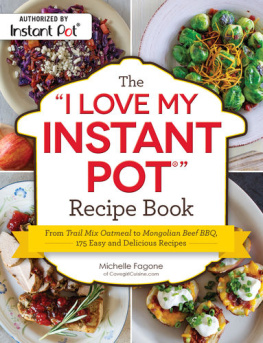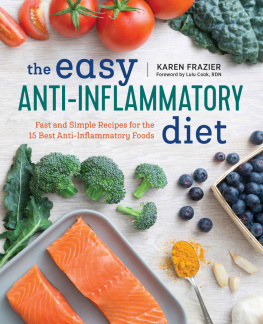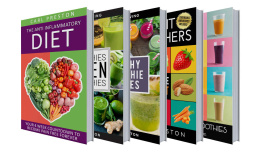Cookbooks:
ANTI INFLAMMATORY
Recipes for Weight Loss and Healthy Living Thank you for purchasing the book,
Diets: Anti Inflammatory Diets for Weight loss and Healthy Living. In this fast paced world, most of us have forgotten to take care of our body. Most of us have forgotten the fact that our body is indeed a temple. You may have started to work too hard or have taken up a certain diet, which asks you to give up on what your body essentially needs. You may have decided to go on a cleanse and have stopped eating. But this is where you are making a mistake. There are a lot of different things that you have forgotten about.
Are you aware that chronic inflammation can cause a number of serious diseases like heart diseases, cancer, and arthritis? So, what is inflammation in the first place? What causes inflammation? How do you address inflammation? I am sure you want answers to some of the questions above after learning that inflammation can actually cause some of the diseases that we have mentioned. This book will help you understand what inflammation is and ways of treating inflammation. You will also learn that your diet plays a very important role in inflammation hence the need to embrace a suitable diet if you want to treat inflammation forever. Through the book you will learn about the different kinds of food that you will need to incorporate in your diet to avoid inflammation. The last chapter of the book leaves you with delicious recipes. You can incorporate these foods in your daily life.
They are not difficult to make. There are mouthwatering desserts that you can enjoy eating! Surprised that there are desserts as a part of your diet? Well, you need to remember that a diet does not necessarily mean that you do not have any chocolate! Thank you once again and I would like to wish you luck on the new path that you have chosen to take!
Before we can look closely at foods that fight inflammation, let us first understand what inflammation is. The inflammation process is one of the ways in which the immune system and the white blood cells react to pathogens such as viruses, bacteria, and fungi. During a major injury to your body, your body triggers scarring, which helps in healing. However, in case you have arthritis, your body may trigger an inflammatory response even when pathogens are absent. Such autoimmune diseases like arthritis cause your immune system to attack your own body cells, which then wreaks havoc in your body.
While some physical symptoms of inflammation may include your body becoming red, being swollen, hot, having chills, fatigue, loss of appetite, headaches, and muscle stiffness, in some cases, these symptoms may not manifest themselves, which makes it very hard for you to even know if you are suffering from inflammation. Inflammation is believed to play a role in heart disease, obesity, and cancer, and is mostly triggered by foods rich in sugar and saturated fats. These food substances make the immune system overactive, contributing to fatigue, joint pain, and damage to blood vessels. By adopting a diet rich in foods that fight inflammation, you can counter toxins and free radicals.
VegetablesCollard greens These dark leafy vegetables are rich in vitamin E, which protects the body against cytokines, pro-inflammatory molecules.
Celery Celery is rich in vitamin C, an antioxidant, and other phenolic antioxidants that act as anti-inflammatory agents.
Celery Celery is rich in vitamin C, an antioxidant, and other phenolic antioxidants that act as anti-inflammatory agents.
Antioxidants help in reducing the oxidative damage to the body fat and minimize the risk associated with oxidative damage to the blood vessel walls. Your cells are shielded away from the free radicals (free radicals are dangerous products that are produced from various metabolic activities). Celery also contains manganese and beta-carotene. Kales Kale is rich in sulfur, a mineral that allows your liver to carry out the two-detox cycles required in the body. The second cycle allows the body to produce more phase II enzymes to breakdown toxins in a similar manner to how digestive enzymes work. Red cabbage It has an anti-inflammatory phytonutrient known as anthocyanin, and a good quantity of polyphenols that combat oxidative stress and inflammation. Broccoli This nutritious vegetable contains kaempferol and sulforaphane, phytonutrients that fight cancer and inflammation. Broccoli This nutritious vegetable contains kaempferol and sulforaphane, phytonutrients that fight cancer and inflammation.
The substances reduce oxidative stress and inflammation, fight allergy and eliminate cancerous toxins from the body. Broccoli is also rich in vitamin C, an antioxidant. Add steamed or raw broccoli florets to salads, soups or use as garnish. Do not overcook broccoli to avoid killing the active ingredients. Beans As opposed to meat that may contain antibiotics, steroids, or hormones, beans are a healthy source of protein that is rich in antioxidants. Beets This red-colored veggie contains antioxidant properties both in the beet and beetroot juice, and is a good remedy for heart disease and cancer. Beets This red-colored veggie contains antioxidant properties both in the beet and beetroot juice, and is a good remedy for heart disease and cancer.
Beets are rich in vitamin C, hearty helping fiber and betalains, a plant pigment. Tomatoes This is considered a nightshade vegetable, as may help some people fight inflammation though might not work for others. The red and juicy tomatoes are rich in lycopene, an active ingredient against inflammation in the lungs and other body parts. Research found out that cooked tomatoes had more lycopene than raw ones, meaning that tomato sauce is more recommendable. Drinking tomato juice is also effective. Spinach This vegetable is rich in carotenoids, an antioxidant that fights inflammation.
Spinach also contains vitamin E. If you want to serve spinach, first steam for a few minutes to facilitate digestion. FruitsAvocados These fruits contain a number of anti-inflammatory substances, among them vitamin C and E, omega 3 fatty acids and minerals such as zinc, selenium and manganese. They also contain phytosterols and carotenoid antioxidants among them alpha-carotene, beta-carotene and lutein. To eat more avocados, include them in desserts, dressings, raw soups and salads. Cranberries The berries contain phytonutrients that heal your cardiovascular system and other parts of the digestive system such as colon, stomach, gums and mouth.
Add cranberries to desserts, salad dressings, and smoothies, either when fresh or frozen. Blueberries The berries are rich in phytonutrients among them hydroxycinnamic acids, anthocyanins and flavanols. These substances work as anti-inflammatory and antioxidants compounds in your body. Add blueberries to salads, cakes, pies and smoothies, or eat the wild and organic berries. Papaya This fruit contains vitamins C, E and beta-carotene, which has the antioxidant properties of papaya. Tart Cherries These cherries contain anthocyanins, antioxidants that fight inflammation. Tart Cherries These cherries contain anthocyanins, antioxidants that fight inflammation.
They work up to 10 times better than aspirin, and are effective in reducing risk of heart disease. Tart cherries are reported to help athletes reduce intake of inflammatory pain meds and thus improve their performance. They can minimize pain from post-exercise soreness and arthritis, and has shown to possess the highest anti-inflammatory properties compared to other food. The recommendable daily intake of tart cherries is a cup of tart cherry juice or 1- cups of tart cherries.

